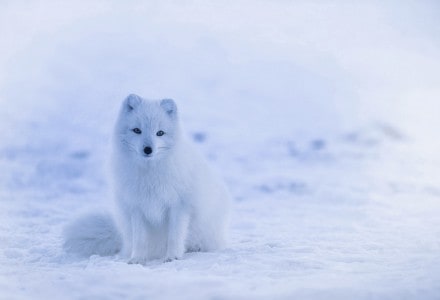
Arctic Fox Facts
- This magnificent mammal most frequently goes by the descriptive and informative common name of the Arctic Fox. The animal has several other general names, though. These include the titles of polar fox, snow fox, and the fully appropriate white fox.
- Within scientific circles, however, it’s better known by its technical name. Fortunately for the average layperson, that’s a relatively simple term, as such things go. That’s because this beautiful wild canine holds the short scientific name of Vulpes lagopus.
- It received that easy to pronounce name due to the efforts of the renowned Swedish zoologist, Carl Linnaeus. He achieved the first recorded acknowledgement of it as a separate and distinct species. He managed this scientifically noteworthy deed in 1758.
- It’s also renowned for several reasons. One is, of course, its sheer beauty. Another distinction it holds is the fact that it’s the only land mammal endemic to the country of Iceland. Four known subspecies of this wonder of Nature also currently exist.
- Despite the extreme harshness of its native habitat, the Arctic Fox seems to be in relatively good shape as a species. The stunning mammal appears to have a population base that’s both sufficient and stable. The IUCN thus presently lists it as Least Concern.
- Nevertheless, it must be considered to be facing at least some threats to its continued existence. Despite being legally protected in parts of its range, illegal hunting of it persists. It also now faces the same threat of ongoing climate change as all species do.
Related Articles
Fennec Fox Dingo Bat Eared Fox
Arctic Fox Physical Description
The stunning Arctic Fox clearly impresses those fortunate to encounter one in the wild. That’s when they can even see it, given its incredible camouflage. The animal achieves that impression due more to its remarkable appearance than its sheer physical size.
That’s because, despite its other wondrous attributes, it’s only an average-sized variety of fox. It also follows another pattern common to its relatives. That’s true since this amazing animal displays the physiological characteristic known as sexual dimorphism.
In its case, this trait manifests itself in terms of pure physical size. More specifically, males attain a larger average body size than their female counterparts. That difference, however, ranks as comparatively minor. Otherwise, the two genders remain virtually indistinguishable.
The males of the species reach an average head-and-body length of approximately 22 in (55 cm). Exceptional specimens sometimes reach 27 in (68 cm). Females, meanwhile, grow to an average length equaling roughly 20 in (52 cm), excluding the tail, of course.
In both sexes of the Arctic Fox, the tail develops as relatively long. This appendage reaches an average length of 12 in (30 cm). The animal also grows to 9.8 – 11.8 in (25 – 30 cm) at the shoulder. Males average 7.7 lb (3.5 kg), while females average 6.4 lb (2.9 kg).
Yet its the mesmerizing coloring of the animal that garners the most attention. Although the young display dark colors, this changes quickly to a dazzling white as they mature. This shade covers the entirety of the body, all the way to the tip of the fluffy tail.
- Kingdom: Animalia
- Phylum: Chordata
- Class: Mammalia
- Order: Carnivora
- Family: Canidae
- Genus: Vulpes
- Species: V. lagopus
Arctic Fox Distribution, Habitat, and Ecology
The beautiful Arctic Fox evolved as native to a surprisingly large region of the world. As its very name implies, this includes the Arctic Circle. But it’s not restricted to that area, though. It appears in the more northern portions of Europe, Asia, and North America.
That range even includes such isolated areas as Iceland, Greenland, Svalbard, and other islands located in the Barents Sea. In Canada, it appears as far south as Hudson Bay. The animal was also previously introduced to the Aleutian Islands southwest of Alaska.
Its habitat consists almost exclusively of regions of Arctic tundra. It also favors sections of pack ice. The animal does manage to survive in a few other habitats, though. These mainly include boreal forests in such places as the Kenai Peninsula and several in Canada.
Within this type of environment, it also appears at a surprising range of altitudes. Many individuals live in regions of up to 9,800 ft (3,000 m) above sea level. Other specimens, though, have been spotted on collections of sea ice very close to the North Pole itself.
Protected by its warm, dense fur, the Arctic Fox evolved as a pure predator. It feeds opportunistically, consuming virtually any prey it finds. This prey typically includes such species as voles, lemmings, birds, hares, eggs, small fish, and even carrion when available.
Intriguingly, it has few natural predators itself, despite its relatively small size. The few creatures that do routinely prey on it include wolves, bears, and golden eagles in some parts of its range. In the wild, few live even one year, but some live as long as 11 years.
Species Sharing Its Range
Bowhead Whale Snowy Owl Narwhal
Check out our other articles on 7 Astounding Polar Creatures, Rainbow Grasshopper, Hawksbill Sea Turtle, Devil’s Walking Stick, Alligator Snapping Turtle, European Honey Buzzard

